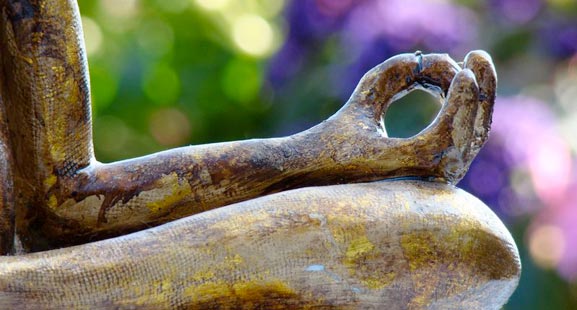
Meditation can be as important as an artist’s brush for finding inspiration and deeper creativity. A mind cluttered with thoughts lacks the space it needs to be most creative. Meditation helps one dissolve internal barriers and allow creativity to flow more freely.
In an interview by The Art of Calligraphy with Nadja Van Ghelue, the artist explains why she began meditating:
After some time I started to have difficulties in the creative process. I wanted to create larger works and I got stuck. I couldn’t maintain the same degree of concentration throughout the work, I interfered too often, and lost the one spirit. Creation became fragmented and in some way unwholesome and forced.
Nadja further remarks that after she began practicing Zen calligraphy, her artistic process was opened to a whole new spiritual dimension.
No methods are taught in Western art to educate and achieve a genuine creative state of mind. I discovered that this was not the case in the East. The calligraphers and painters of the East show a direct path to cultivate this creative state of mind. Their whole philosophy integrates life, spirituality and art, and art becomes a way of living.
Nadja meditates every day: formal sitting meditation, shamatha and vipashyana. She says these meditations give her higher clarity of mind and make her more aware and receptive – indispensible tools for an artist.
Meditation can be used, also, by those observing a finished work of art, to more thoroughly connect with and appreciate it.
Meditative contemplation of art animates us and everything we see. From Psychology Today, Arthur Zajonc, a meditation teacher, was invited to lead an exercise at the Mead Art Museum. There, he instructed students in contemplative engagement with works of art to, quite literally, bring them to life.
Settle not only your body, but also your mind, letting go of tensions, thoughts, worries, and all distractions. You may find that you are helped in this by closing your eyes and attending to your breath. With each out-breath relax further. Once settled, open your eyes and rest them gently on the painting, first noting without thinking, some of the myriad details of the painting…
After a time, soften and widen your gaze so that instead of individual particulars you see the relationships within the painting: light and dark, movement and stillness, diagonal and vertical, anguish and objectivity… Each of these polarities animates the canvas. As we become increasingly aware of them and strive to hold them all simultaneously in our gaze, then does the painting indeed awaken, come alive.
Contemplating art, or anything before us for that matter, can awaken it with a new beauty we may have never noticed before!
Whether you are an artist seeking inspiration or an observer seeking the ultimate artistic experience, meditating is a tool that will help you achieve it.
What’s your experience? Are you an artist that meditates? What effect did it have on your creativity? Tell us about it using the comment box below.


